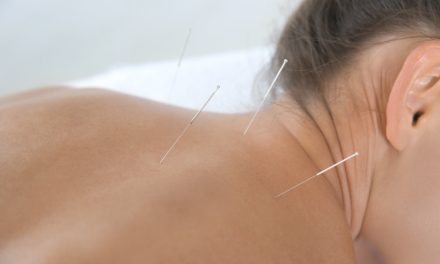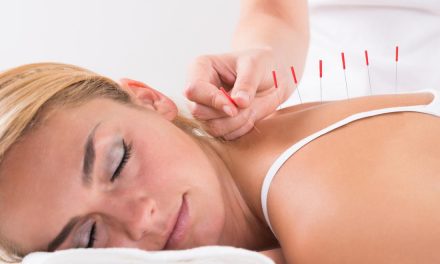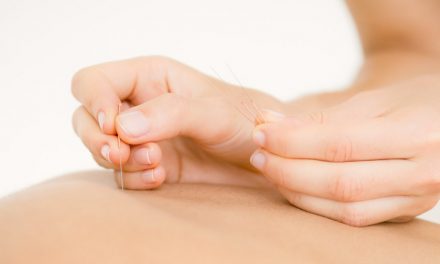Acupuncture helps to heal peptic ulcers and prevents relapses. Researchers conclude that acupuncture increases the total effective rate of drug therapy for the treatment of peptic ulcers. Researchers from the Second Affiliated Hospital of Zhongnan University (Hunan, China) combined acupuncture with standard drug therapy. Patients receiving both drug therapy and acupuncture in a combined treatment protocol had superior patient outcomes compared with patients receiving only drug therapy. Furthermore, acupuncture increases the H. pylori-negative conversion rate and decreases the recurrence rate of drug therapy. [1] In a significant finding, acupuncture added to usual care reduces the relapse rate from 41.7% to 15.4%.
Two groups were compared. In one group, patients received bismuth subnitrate (known by the trade name Veytalo) tablets and amoxicillin as a means to control H. pylori infection. In the second group, bismuth subnitrate and amoxicillin were combined with acupuncture therapy. The drug control group achieve an 82.2% total effective rate. The acupuncture treatment group achieve a 95.6% total effective rate. In addition, the drug control group had a 71.1% H. pylori-negative conversion rate. The acupuncture treatment group had an 86.7% H. pylori-negative conversion rate (i.e., 86.7% of patients were no longer positive for the presence of Helicobacter pylori).
In a 12-month follow-up examination, patients receiving only drug therapy had a 41.7% recurrence rate of peptic ulcers. Patients receiving drug therapy plus acupuncture had a 15.4% recurrence rate. The researchers conclude that adding acupuncture to a bismuth subnitrate plus amoxicillin treatment regimen consolidates the treatment effects and prevents possible recurrence and necessitation for drug therapy.
Chinese Medicine Theory
Peptic ulcers are a common health problem that occur in the stomach (gastric ulcers) or the upper part of the small intestine, typically manifesting in duodenal ulcers. [2] In Traditional Chinese Medicine (TCM), peptic ulcers are in the scope of stomach duct pain (Wei Wan Tong), acid swallowing (Tun Suan), and blood ejection (Tu Xue). TCM principles specify that peptic ulcers are often due to dysfunction of the stomach, spleen, and liver. TCM principles also notate that spleen and stomach weakness is the underlying root cause of the disease. In the Incisive Light on the Source of Miscellaneous Disease (Za Bing Yuan Liu Xi Zhu), it is written that “Stomach disease is often due to pathogenic factors invading the stomach. When there is harmonious flow of abundant qi and blood, the stomach becomes so strong that pathogenic factors cannot affect it; if not, the stomach becomes so weak that pathogenic factors can easily affect it and cause stomach diseases.” The therapeutic treatment principles are to fortify the spleen, harmonize the stomach, and rectify qi to relieve pain.
Design
The researchers (Li et al.) used the following study design. A total of 90 human patients that were diagnosed with peptic ulcers were treated and evaluated in this study. Patients were randomly divided into an acupuncture therapy treatment group and a drug monotherapy control group, with 45 patients in each group. For the control group patients, bismuth subnitrate tablets and amoxicillin were administered. The combination of bismuth subnitrate with antibiotics has been used to treat Helicobacter pylori infections in clinical settings and was therefore chosen as the standard of usual care. The acupuncture therapy treatment group received acupuncture sessions in addition to the identical drug therapy administered to the drug control group.
Prior to beginning the study, both groups were comprised of equivalent demographic constituents. The acupuncture treatment group was comprised of 26 males and 19 females. The average age in the acupuncture group was 41.65 (±1.35) years. The average course of disease in the treatment group was 5.5 years. The drug control group was comprised of 28 males and 17 females. The average age in the drug control group was 40.18 (±0.35) years. The average total course of the disease in the drug control group was 5.8 years. For both groups, there were no significant differences in gender, age, and course of disease prior to beginning the investigation.
Drug and Acupuncture Treatment
For the drug control group, patients received 110 mg doses of bismuth subnitrate tablets and 250 mg of amoxicillin (orally administered, 4 times each day). Every 7 days of tablet consumption consisted of one treatment course. A total of 2 courses were administered. The acupuncture group received a combination of acupuncture and drug therapy. The needle retention time was 10 – 30 minutes. Acupuncture was administered once per day, 5 days per week, followed by a 2-day break. Each treatment course consisted of 2 weeks of acupuncture treatments. All patients received 2 treatment courses in total. A total of 2 – 3 primary acupoints were selected from the following list:
- BL20 (Pishu)
- BL21 (Weishu)
- CV12 (Zhongwan)
- ST36 (Zusanli)
- PC6 (Neiguan)
Additional acupoints were selected on individual symptomatic presentations. The acupoint selection was based on the Traditional Chinese Medicine (TCM) theory of differential diagnosis by pattern differentiation. For disturbed qi dynamics, the following acupoints were added:
- LV14 (Qimen)
- LV2 (Xingjian)
- BL18 (Ganshu)
For qi and blood stagnation, the following acupoints were added:
- BL17 (Geshu)
- SP6 (Sanyinjiao)
For stomach yin deficiency, the following acupoints were added:
- SP6 (Sanyinjiao)
- KI3 (Taixi)
For a cold and deficient stomach and spleen, the following acupoints were added:
- CV4 (Guanyuan)
- CV6 (Qihai)
Point Selection
Neiguan (PC6) is located 2 cun superior to the transverse crease of the wrist. This acupoint was selected because it is located on the pericardium meridian and is one of the confluent points of eight extra meridians, which makes it not only indicated for heart and chest diseases, but also spleen and stomach dysfunction. In Traditional Chinese Medicine (TCM), the heart (fire) is the mother of spleen (earth). Therefore, needling Neiguan is beneficial to the spleen. This is a basic five element implementation of the mother nourishes child principle; in this case, stimulating the pericardium meridian with the acupoint PC6 (Neiguan) supports the spleen and stomach.
Zusanli (ST36) is located below the knee. This acupoint is the He-Sea point of the stomach meridian. Zhongwan (CV12) is the Front-Mu point of the stomach meridian. Needling these two points regulates the spleen and stomach, tonifies qi and blood, and strengthens areas of weakness. Pishu (BL20) and Weishu (BL21) are the Back-Shu points of the spleen meridian and stomach meridians respectively. In TCM, Back-Shu points are the gathering places for the essence of their corresponding Zang-Fu organs. Needling Pishu and Weishu tonifies the spleen and stomach.
Modern research confirms that Zusanli and Zhongwan benefit gastrointestinal function. For example, researchers from the Hubei University of Traditional Chinese Medicine (Chen et al.) tested Zusanli in a controlled experiment and confirm that it is effective for benefiting the stomach. [3] In the experiment, rats had improved stomach acid levels and gastrointestinal motility. In an independent research, Luo et al note, “Needling Zusanli and Zhongwan has a bidirectional regulation on stomach acid levels and gastric pepsin levels.” They add that “Needling these points can stimulate the vagus nerve and inhibit acid secretion in people who develop gastric ulcers.” [4] Given the historical TCM indications and proven modern applications of Zusanli (ST36) and Zhongwan (CV12), Li et al. combined both acupoints into an acupuncture treatment protocol to determine their effects on peptic ulcers.
Results
The results indicate that acupuncture combined with conventional drug therapy into an integrated treatment protocol is more effective than bismuth subnitrate plus amoxicillin as a standalone therapy. Li et al. conclude that acupuncture is safe and effective for the alleviation of peptic ulcers.
Notes
[1] Li YM, Wu Q. Clinical Observation on 45 Cases of Peptic Ulcer Treated with Acupuncture [J]. Guiding Journal of Traditional Chinese Medicine and Pharmacy, 2008(06):84-85.
[2] kidshealth.org/en/parents/peptic-ulcers.html.
[3] Chen XH, Liu YX, Wang H. Comparative Study on the Effect of Acupuncture and Moxibustion “Zusanli and Guanyuan” on Immune Function of Rats with Yang Deficiency [J]. Chinese Acupuncture & Moxibustion, 1999, 18(9): 555.
[4] Luo YF. Analysis of the Saying which goes “Zusanli is indicated for stomach diseases” [J]. Chinese Acupuncture & Moxibustion, 1997, 16 (6): 38.






Recent Comments